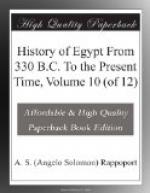Caesar had left behind him, in the neighbourhood of Alexandria, a large body of Roman troops, in the pay and nominally under the orders of Cleopatra, but in reality to keep Egypt in obedience. There they lived as if above all Egyptian law or Roman discipline, indulging in the vices of that luxurious capital. When some of them in a riot, in the year 45 B.C., killed two sons of Bibulus the consul, Cleopatra was either afraid or unable to punish the murderers; the most she could do was to get them sent in chains into Syria to the grieving father, who with true greatness of mind sent them back to the Egyptian legions, saying that it was for the senate to punish them, not for him.
While Ptolemy her second husband was a boy and could claim no share of the government, he was allowed to live with all the outward show of royalty, but as soon as he reached the age of fifteen, in B.C. 44, at which he might call himself her equal and would soon be her master, Cleopatra had him put to death. She had then reigned four years with her elder brother and four years with her younger brother, and from that time forward she reigned alone, calling her child by Caesar her colleague on the throne.
At a time when vice and luxury claimed the thoughts of all who were not busy in the civil wars, we cannot hope to find the fruits of genius in Alexandria; but the mathematics are plants of a hardy growth, and are not choked so easily as poetry and history. Sosigenes was then the first astronomer in Egypt, and Julius Caesar was guided by his advice in setting right the Roman Calendar. He was a careful and painstaking mathematician, and, after fixing the length of the year at three hundred and sixty-five days and a quarter, he three times changed the beginning of the year, in his doubts as to the day on which the equinox fell; for the astronomer could then only make two observations in a year with a view to learn the time of the equinox, by seeing when the sun shone in the plane of the equator. Photinus the mathematician wrote both on arithmetic and geometry, and was usually thought the author of a mathematical work published in the name of the queen, called the Canon of Cleopatra.




